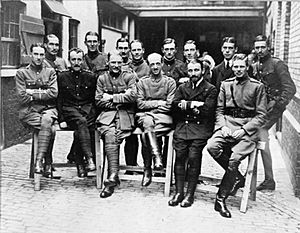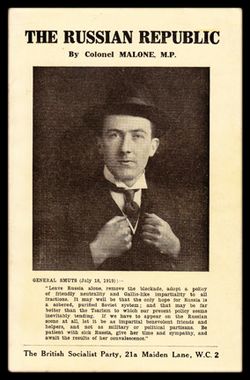Cecil Malone facts for kids
Quick facts for kids
Cecil L'Estrange Malone
|
|
|---|---|

Lt. Cecil Malone (rear row, 3rd from r.) with other pioneering officers of the RFC in 1913, including Charles Samson of the HMS Ben-my-Chree
|
|
| Parliamentary Private Secretary to the Minister for Pensions | |
| In office 1931–1931 |
|
| Prime Minister | Ramsay MacDonald |
| Minister | Frederick Roberts |
| Member of Parliament for Northampton |
|
| In office 9 January 1928 – 7 October 1931 |
|
| Preceded by | Arthur Holland |
| Succeeded by | Mervyn Manningham-Buller |
| Member of Parliament for Leyton East |
|
| In office 14 December 1918 – 26 October 1922 |
|
| Preceded by | New constituency |
| Succeeded by | Ernest Edward Alexander |
| Personal details | |
| Born |
Cecil John L'Estrange Malone
7 September 1890 |
| Died | 25 February 1965 (aged 74) |
| Nationality | British |
| Spouse | Leah Kay |
| Military service | |
| Allegiance | United Kingdom |
| Branch/service | Royal Navy Royal Air Force |
| Years of service | 1905–1919 |
| Rank | Lieutenant (RN) Lieutenant Colonel (RAF) |
| Commands | HMS Engadine HMS Ben-my-Chree East Indies and Egypt Seaplane Squadron |
| Awards | Order of the Nile Officer of the Order of the British Empire (revoked in 1921) |
Cecil John L'Estrange Malone (born September 7, 1890 – died February 25, 1965) was a British politician and a brave early pilot in the navy. He made history as the United Kingdom's first Member of Parliament (MP) who was part of the Communist Party.
Contents
Early Life and Military Adventures
Cecil Malone was born in Dalton Holme, Yorkshire, on September 7, 1890. His father was Reverend Savile L'Estrange Malone. He was also related to famous sisters Constance Markievicz and Eva Gore-Booth.
Malone went to Cordwalles School before joining the Royal Navy in 1905. He trained to become an officer at the Royal Naval College, Dartmouth. By March 1910, he was officially a sub-lieutenant.
In 1911, he was chosen for the second group of students to attend the Naval Flying School, Eastchurch. He was promoted to lieutenant in December 1911. Malone earned his pilot's license, called a Royal Aero Club certificate, in March 1912. He was known for flying a special twin-engined biplane. He even managed to fly a plane off the front of a moving ship, HMS London, which was going at 12 knots!
World War I Heroics
During the First World War, Malone led Royal Naval Air Service (RNAS) planes. He took part in the Cuxhaven Raid on December 25, 1914. From August 1914 to March 1915, he was the captain of HMS Engadine. This ship was a cross-channel steamer that had been changed into a seaplane carrier.
From March 1915 to April 1916, he captained HMS Ben-my-Chree, another steamer converted to carry seaplanes. Under Malone's leadership, seaplanes from Ben-my-Chree were the first ever to carry torpedoes. They successfully hit three enemy ships with torpedoes in 1916. After this, Malone commanded the East Indies and Egypt Seaplane Squadron. For his bravery and leadership, he received the Fourth Class of the Order of the Nile.
In 1918, Malone worked for the Admiralty's Plans Division. He then became the first British Air Attache at the British Embassy in Paris. In this role, he represented the air forces at the Supreme War Council in Versailles. He was also given the Officer of the Order of the British Empire (OBE) award for his efforts during the war.
Early Political Career
After the war, Malone became involved in politics. He was elected as a Coalition Liberal Member of Parliament (MP) for East Leyton in the 1918 general election. At first, he was part of a group that was against communism. He even wrote articles criticizing left-wing activists. People were surprised when he later changed his mind and supported communism.
Journey to Russia
In September 1919, Cecil Malone traveled to Soviet Russia, even though the country was blockaded. He met with important leaders of the trade union movement in Petrograd. Then, he went to Moscow.
In Moscow, Malone met with important officials like Maxim Litvinov and Georgy Chicherin. He even traveled with Red Army leader Leon Trotsky on his special train to inspect troops. On this trip, he also met other key figures like Alexei Rykov and Anatoly Lunacharsky.
During his visit, Malone explored factories, theaters, power stations, and government offices. He was very impressed by the Bolshevik government's efforts to rebuild the economy. After this trip, he became a strong supporter of communism.
Becoming the First Communist MP
When he returned to England, Malone became active in the Hands Off Russia campaign. In November 1919, he joined the British Socialist Party (BSP), which was a group that later helped form the Communist Party. In the summer of 1920, the BSP became a main part of the Communist Party of Great Britain (CPGB). This made Cecil Malone the first ever CPGB Member of Parliament. He was even elected to the new party's main committee.
Malone's sudden change to revolutionary politics surprised many. Some people, like John Maclean, even questioned if he was truly a communist. Malone got into trouble for some strong words he used in a speech. He suggested that during a revolution, some important people might be harmed. Despite this, the Communist Party supported him. Because of his actions during the war, his OBE award was taken away on June 24, 1921.
Malone was closely watched by Special Branch, a police unit that dealt with "Bolshevik subversion." He often appeared in reports about revolutionary groups in the UK. Malone also worked to get the CPGB to join the Labour Party. He believed this would help unite the parties.
Later Political and Military Career
In 1922, Malone left the Communist Party of Great Britain. He joined the Independent Labour Party, which was connected to the Labour Party. He tried to become an MP for Ashton-under-Lyne in the 1924 election but didn't win.
However, in 1928, he was elected as the MP for Northampton. He won again in the 1929 general election. In 1931, he served in Ramsay MacDonald's government as an assistant to the Minister of Pensions, Frederick Roberts. He lost his seat in the 1931 general election.
Return to Service in World War II
Malone returned to military service during the Second World War. In 1942, he was a staff officer for the chief warden of the City of Westminster Civil Defence. From 1943 to 1945, he worked in the Admiralty Small Vessels Pool.
After the war ended in 1945, he became the Vice President of the Royal Television Society. He also founded and chaired the Radio Association and became a fellow of the Royal Aeronautical Society. He wrote several books, including The Russian Republic, New China, and Manchukuo: Jewel of Asia.
Later Life
Cecil Malone married Leah Kay in 1921. After she passed away, he remarried in 1956. He died on February 25, 1965, at the age of 74.


